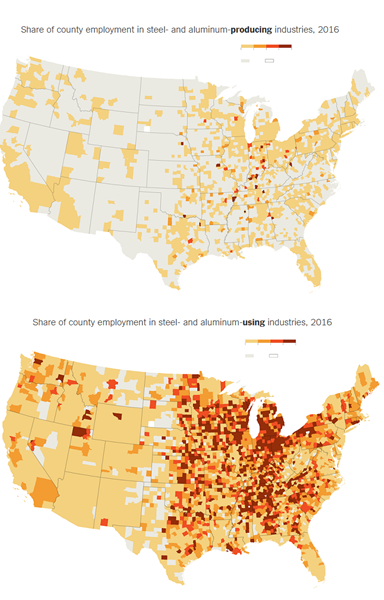
The US maps below show: a) the share of each US county’s employment in steel- and aluminum-producing industries in 2016 (top map) and b) the share of each US county’s employment in steel- and aluminum-using industries (bottom map).

The maps were featured in a recent New York Times article titled “How Trump’s Protectionism Could Backfire.” Here’s a slice:
Tupelo fell hard for Donald Trump. The blue-collar enclave in northeastern Mississippi — birthplace of Elvis Presley and the American Family Association — was once home to a vibrant business in upholstered furniture. But as Chinese imports flooded in, the local economy buckled. There are fewer jobs in Tupelo today than there were at the millennium. Middle-income families are making almost 20 percent less, after inflation, than they did then. Mr. Trump’s offer to build a wall against Chinese imports was just what Tupeloans wanted to hear.
Republicans could not lose in this deep red enclave in the buckle of the Bible Belt. Still, in the 2016 election, Mr. Trump carried Lee County, where Tupelo sits, by a 38-percentage-point margin over Hillary Clinton — nine percentage points more than Mitt Romney’s lead over Barack Obama four years before. And yet it’s not working out great for the working men and women of Tupelo. Indeed, President Trump’s first big trade barrier — tariffs against steel and aluminum imports — is, again, threatening to undermine their livelihood.
For every job in Tupelo producing steel or aluminum, there are 200 jobs in industries that consume them that could be put at risk as tariffs push up the prices of these metals, according to research from Jacob Whiton and Mark Muro of the Brookings Institution. This is true across the country (see maps).The lesson the White House has yet to figure out is that the tariffs meant to protect the businesses that make these metals will end up hamstringing the industries that rely on them.
















